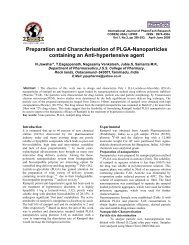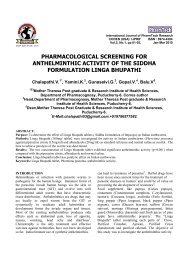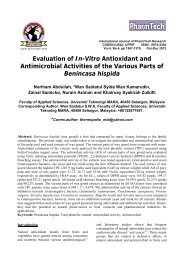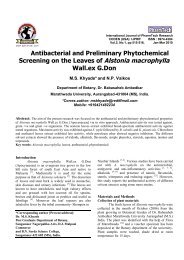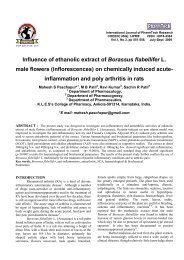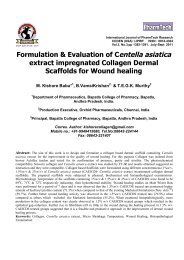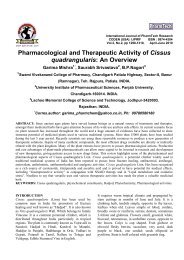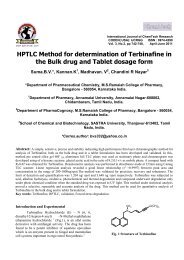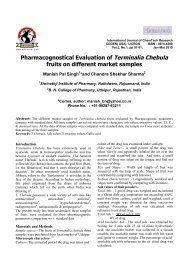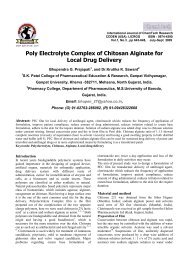Phytochemical Profiling And GC-MS Study Of Antigonum leptopus ...
Phytochemical Profiling And GC-MS Study Of Antigonum leptopus ...
Phytochemical Profiling And GC-MS Study Of Antigonum leptopus ...
You also want an ePaper? Increase the reach of your titles
YUMPU automatically turns print PDFs into web optimized ePapers that Google loves.
International Journal of ChemTech Research<br />
CODEN( USA): IJCRGG ISSN : 0974-4290<br />
Vol.5, No.4, pp 1630-1640, April-June 2013<br />
<strong>Phytochemical</strong> <strong>Profiling</strong> <strong>And</strong> <strong>GC</strong>-<strong>MS</strong> <strong>Study</strong> <strong>Of</strong> <strong>Antigonum</strong><br />
<strong>leptopus</strong> Hook & ARN.<br />
Vanitha K 1 *, Thangarasu S 2 .<br />
1 Faculty of Marine Sciences, CAS in Marine Biology, Annamalai University,<br />
Parangipettai-608 502<br />
2 PG Department of Botany, Periyar EVR College, Trichy-620 023<br />
*Corres. author: vanithakrish84@gmail.com<br />
Mobile No: 91- 9442858510<br />
Abstract: The present study investigated the chemical constituents of a traditionally used ethanobotanical plant<br />
<strong>Antigonum</strong> <strong>leptopus</strong> using a <strong>GC</strong>-<strong>MS</strong> approach. <strong>Phytochemical</strong> analysis of <strong>Antigonum</strong> <strong>leptopus</strong> revealed the<br />
presence of alkaloids, saponium, steroid, phenolic compounds, fatty acids, flavonoids and volatile oils in leaves<br />
and tubers. Interestingly, ten phytochemical constituents were analyzed and characterized by <strong>GC</strong>-<strong>MS</strong> that<br />
confirmed the presence of (1) Glycerin (2.49%), (2) Propane,1,1,3-triethoxy (4.09%), (3) 4H-pyran-4-one,2,3dihydro-3,5-dihydroxy-6-methyl-<br />
(14.34%), (4) methyl salicylate (1.14%), (5) 2-furancarboxaldehyde,5-<br />
(hydroxymethyl)- (24.45%), (6) dodecanoic acid (1.89%), (7) 1,2-Benzenedicarboxylic acid, bis(2methylpropyl)ester<br />
(6.06%), (8) n -hexadianoic acid (15.20%), (9) oleic acid (18.02%) and (10) 1,2-<br />
Benzenedicarboxylic acid, diisooctyl ester (12.33%). Results from this work indicated useful information on the<br />
phytochemistry of A. <strong>leptopus</strong> tuber, which can pave way to further applications and utility in the<br />
pharmaceutical and neutraceutical field.<br />
Keywords: <strong>Antigonum</strong> <strong>leptopus</strong>, <strong>GC</strong>-<strong>MS</strong>, <strong>Phytochemical</strong> component.<br />
Introduction<br />
According to World health organization, medicinal plants would be the best source to obtain a variety of drugs.<br />
About 80% of individuals from developed countries use traditional medicine, which has been derived from<br />
medicinal plants. The medicinal plants are of great important to the health of individual and communities. The<br />
medicinal value of these plants lie in some active chemical substances called phytochemical that produce a<br />
physiological action on the human body. <strong>Phytochemical</strong>s are naturally occurring biochemical compounds in<br />
plants for color, flavor, smell and texture for pollination and define mechanism. Some plant secondary<br />
metabolites such as alkaloids, phenols, tannins, glycosides, terpenoids, saponins, flavonoids and steroids have<br />
been implicated in their ability to inhibit the formation of pro-inflammatory signaling molecules such as<br />
prostaglandin or leukotrienes 1 .<br />
However, such plants should be investigated to better understand their properties, safety and efficiency 2 .<br />
The herbal plant <strong>Antigonum</strong> <strong>leptopus</strong> are widely used by the tribal people as an efficient medicine that cures<br />
piles. Therefore, this study is conducted to provide a thorough knowledge on the tribal plant A. <strong>leptopus</strong>.<br />
Studies based on the ethnobotanical use of plants have often provided a more efficient method of drug discovery<br />
than random screening 3-4 . In the present study, we evaluated phytochemical screening of leaf and tuber of A.
Vanitha K et al /Int.J.ChemTech Res.2013,5(4) 1631<br />
<strong>leptopus</strong> on the quantitative and qualitative analysis by using the <strong>GC</strong>-<strong>MS</strong> method for the identification of<br />
compounds and their activity based on ethanobotanical databases.<br />
Materials and methods<br />
Plant material<br />
The plant materials such as leaves and tubers were collected from the college outskirt region of the campus of<br />
H.H. The Rajah’s College, Pudukkottai, a distinct headquarters of Tamilnadu state. The vegetative parts, leaves<br />
and tubers from A. <strong>leptopus</strong>, belonging to the family Polygonaceae was employed for the analysis. Herbarium<br />
specimens of the plant parts were prepared and deposited as voucher specimens in the departmental herbarium<br />
for future verification. The fresh leaves and tuber were dried thoroughly under shade and powdered finely and<br />
stored in a clean plastic container for phytochemical analysis.<br />
<strong>Phytochemical</strong> estimation<br />
The phytochemical estimation from fresh leaves and tuber powder of A. <strong>leptopus</strong> were quantitatively determined<br />
by adopting standard protocols viz., Chlorophyll 5 , carotenoid 6 , total soluble sugars 7 and total soluble starch 8<br />
using glucose as standard, total soluble proteins 9 by using bovine serum albumin as standard, total free amino<br />
acids 10 using leucine as standard, total phenols 11 using catechol as standard, hydroxy phenols 12 using catechol as<br />
standard. All experiments were repeated three times for precision and values were expressed in mean ± standard<br />
deviation in terms of fresh leaves and air dried tuber.<br />
Preparation of plant extracts<br />
Twenty gram of tuber powder was soaked in 50 ml of absolute alcohol overnight for alcoholic extraction. It was<br />
filtered through Whattmann filter paper No. 41 along with 2gm sodium sulfate which had been wetted with<br />
absolute alcohol to remove the sediments and traces of water in the filtrate. Then the filtrates were concentrated<br />
by bubbling nitrogen gas into the solution and reduce the volume to 1 ml. The extract contained both polar and<br />
non-polar phytochemical components.<br />
<strong>GC</strong>-<strong>MS</strong> analysis<br />
The plant sample (tuber extract) wa s analyzed in a Perkin Elmer <strong>GC</strong> Clarus 500 <strong>MS</strong> system for different<br />
components present in the extract, under the following conditions: column– dimethyl polysiloxane DB-1 fused<br />
silica capillary column (30m x 0.25 mm x 0.1µm of film thickness); carrier gas – helium (1ml / min); injector<br />
temperature –250 o C; detector temperature - 200 o C; column temperature – 35-180 o C at 4 o C / min – then 180 –<br />
250 o C at 10 o C / min; <strong>MS</strong> electron impact 70 eV.<br />
Identification of compound<br />
Interpretation on mass spectrum of <strong>GC</strong>-<strong>MS</strong> was conducted using the database of National Institute Standard and<br />
Technology (NIST Ver.2.1) having more than 62,000 patterns. The spectrum of the unknown component was<br />
compared with the spectrum of the known components stored in the NIST library. The name, molecular weight<br />
and structure of the components of the test materials were identified. The activity of the tuber extract of<br />
biochemical compound was compared with Dr. Duke's <strong>Phytochemical</strong> and Ethnobotanical Databases.<br />
Results<br />
The present study carried out on the plant samples revealed the presence of medicinally active constituents.<br />
Quantitative estimation of the biochemical compounds of the plant parts such as leaf and tuber was studied and<br />
summarized in Table 1. The content of pigments like total chlorophyll (1.452± 0.06), chlorophyll a (0.772±<br />
0.33), chlorophyll b (0.681± 0.02), and carotenoid (0.632± 0.05) in leaves and the components like total soluble<br />
sugars (312.31±12.76), total soluble starch (107.12±3.5) , total soluble proteins (31.21±1.04) and free amino<br />
acids (76.32±4.49) as well as phenols (42.41±2.34) and total hydroxyphenols (156.13±5.73) in tubers was<br />
comparatively higher than that of leaves.<br />
The presence of secondary metabolites in the leaf and tuber of the A. <strong>leptopus</strong> investigated were<br />
summarized in Table 2. The results show that the presence of saponin, steroid / triterpenoid, phenolic<br />
compounds, fatty acid, flavonoids and volatile oils were present in leaf and tuber of the plant. Tannins and<br />
glycosides were absent in leaf and tuber respectively, whereas alkaloids were present in the tuber.
Vanitha K et al /Int.J.ChemTech Res.2013,5(4) 1632<br />
Table 1. Basic biochemical components in leaves and tubers of <strong>Antigonum</strong> <strong>leptopus</strong> Hook.&Arn.<br />
S.No Basic biochemical<br />
components<br />
Leaf (mg g -1 f.w. ) Tuber (mg g -1 d.w.)<br />
1 Chl. a<br />
0.772± 0.33 -<br />
Chl. b<br />
0.681± 0.02 -<br />
Total chl.<br />
1.452± 0.06 -<br />
2 Carotenoids 0.632± 0.05 -<br />
3 Total soluble sugar 47.72± 2.49 312.31± 12.76<br />
4 Total soluble starch 42.51± 2.54 107.12± 3.5<br />
5 Total soluble proteins 13.83± 0.65 31.21± 1.04<br />
6 Total free amino acids 18.22± 4.71 76.32± 4.49<br />
7 Total phenols 20.32± 1.29 42.41± 2.34<br />
8 Hydroxy phenols 20.71± 1.43 156.13± 5.73<br />
Table 2. Qualitative analysis of phytochemicals from <strong>Antigonum</strong> <strong>leptopus</strong> Hook. & Arn.<br />
S.No. Name of the compounds Plant parts<br />
Leaf Tuber<br />
1 Alkaloids - +<br />
2 Tannin - -<br />
3 Saponin + +<br />
4 Triterpenoid + +<br />
5 Phenolic compounds + +<br />
6 Fatty acid + +<br />
7 Flavonoids + +<br />
8 Glycoside - -<br />
9 Volatile oils + +<br />
+ = Presence of constituent<br />
- = Absence of constituent<br />
<strong>GC</strong>-<strong>MS</strong> chromatogram of the alcoholic extract of A. <strong>leptopus</strong> showed ten peaks indicating the presence<br />
of ten compounds. The chemical compounds and there activity in the alcoholic extract of A. <strong>leptopus</strong> are<br />
presented in Table 3, 4 and Figure 1. The ten phytochemical constituents characterized by <strong>GC</strong>-<strong>MS</strong> peak are as<br />
follows: (1) Glycerin (2.49%), (2) Propane,1,1,3 -triethoxy (4.09%), (3) 4H -pyran-4-one,2,3-dihydro-3,5dihydroxy-6-methyl-<br />
(14.34%), (4) methyl salicylate (1.14%), (5) 2 -furancarboxaldehyde,5-(hydroxymethyl)-<br />
(24.45%), (6) dodecanoic acid (1.89%), (7) 1,2-Benzenedicarboxylic acid, bis(2-methylpropyl)ester(6.06%), (8)<br />
n-hexadianoic acid(15.20%), (9) oleic acid (18.02%) and (10) 1,2 -Benzenedicarboxylic acid, diisooctyl<br />
ester(12.33%). The properties of the compounds and their bioactivities based on Dr. Duke’s phytochemical and<br />
Ethnobotanical databases are listed below.<br />
Compound 1 was detected as Glycerin and its molecular formula was assigned to be C3H8O3 compound<br />
nature was alcohol group, based on the high-resolution <strong>GC</strong>-<strong>MS</strong> spectrum. The spectral features and<br />
physicochemical properties revealed 1 to be Glycerol. This compound showed RT as 4.07, molecular wt as 92;<br />
and peak area as 2-49% (Figure 2.A). It showed the following bioactivities, based on Dr. Duke’s phytochemical<br />
and Ethnobotanical databases: Hygrospic action, anti-inflammatory and antimicrobial properties and also used<br />
as softening agent and preservative. It had the following other synonyms: 1. 1,2,3-Propanetriol, 2. Glycerol, 3.<br />
Glycerine, 4. Glyceritol, 5. Glycyl alcohol,6. Glyrol, 7. Glysanin, 8. Osmoglyn, 9. Propanetriol, 10.<br />
Trihydroxypropane, 11. Synthetic glycerin, 12. 90Technical glycerin, 13. Dagralax and 14. Glycerin anhydrous.<br />
Compound 2 was detected as Propane, 1,1,3-triethoxy- and its molecular formula was assigned to be<br />
C9H20O3, compound nature was found to be belong to ether compound, based on the high-resolution <strong>GC</strong>-<strong>MS</strong><br />
spectrum. The spectral features and physicochemical properties revealed 2 to be -Ethoxypropionaldehyde<br />
diethyl acetal. This had 5.93 RT, 176 molecular wt. as 4.09 peak area % (Figure2.C). It showed the following<br />
bioactivities, based on Dr. Duke’s phytochemical and Ethnobotanical databases: No activity was reported so for.<br />
It had the following other synonyms: 1. -Ethoxypropionaldehyde diethyl acetal; 2. 3-Ethoxypropionaldehyde
Vanitha K et al /Int.J.ChemTech Res.2013,5(4) 1633<br />
diethyl acetal; 3. Propionaldehyde, 3-ethoxy-, diethyl acetal; 4. 1,1,3-Triethoxypropane; 5. Propane, 1,3,3triethoxy-<br />
6. 1,3,3-Triethoxypropane.<br />
Compound 3 was detected as 4H-Pyran-4-one, 2, 3-dihydro-3, 5-dihydroxy-6-methyl- and its molecular formula<br />
was assigned to be C6H8O4 and compound nature was found to be Pyran ring, based on the high-resolution<br />
<strong>GC</strong>-<strong>MS</strong> spectrum. The spectral features and physicochemical properties revealed 3 to be 4H-Pyran-4-one, 2, 3dihydro-3,5-dihydroxy-6-methyl-.<br />
This had 7.58RT, 144 molecular wt and 14.34 % peak area (Figure 2.B). It<br />
showed the following bioactivities, based on Dr. Duke’s phytochemical and Ethnobotanical databases: No<br />
activity was reported. It had the following other synonym: 3,5-Dihydroxy-6-methyl-2,3-dihydro-4H-pyran-4one<br />
.<br />
Compound 4 was detected as Methyl Salicylate and its molecular formula was assigned to be C8H8O3,<br />
based on the high-resolution <strong>GC</strong>-<strong>MS</strong> spectrum. The spectral features and physicochemical properties revealed 4<br />
to be Methyl Salicylate. This compound showed RT as 8.78, molecular wt. as 152; and peak area as 1.14%<br />
(Figure 2.D ). It showed the following bioactivities, based on Dr. Duke’s phytochemical and Ethnobotanical<br />
databases: antipyretic, anti-inflammatory, analgesic, antiseptic, pesticide, insecticide, cancer-preventive<br />
carminative and perfumery. It had the following other synonyms: 1.Benzoic acid, 2-hydroxy-methylester;<br />
2.Salicylic acid, methyl ester; 3.o-Hydroxybenzoic acid, methyl ester;4.Analgit; 5.Betula;6.Betula oil; 7.Betula<br />
Lenta; 8.Exagien; 9.Flucarmit;10.Gaultheria oil;11.Gaultheria Oil, artificial; 12.Gaultheriaoel; 13.Methylohydroxybenzoate;<br />
14.Methyl2-hydroxy; benzoate;15.Oil of Wintergreen.<br />
Compound 5 was detected as 2-Furan carboxaldehyde, 5-(hydroxymethyl)-and its molecular formula<br />
was assigned to be C6H6O3 compound nature was lauric acid, based on the high-resolution <strong>GC</strong>-<strong>MS</strong> spectrum.<br />
The spectral features and physicochemical properties revealed 5 to be 2-Furancarboxaldehyde, 5-<br />
(hydroxymethyl)-. This compound showed RT as 9.03, molecular wt as 126; and peak area as 24.45%<br />
(Figure2.E). It showed the following bioactivities, based on Dr. Duke’s phytochemical and Ethnobotanical<br />
databases: antimicrobial, preservative. It had the following other synonyms: 1.2-Furaldehyde, 5-<br />
(hydroxymethyl)-; 2.5-Hydrxoymethylfurfural; 3.Hydroxymethylfurfurole; 4.HMF;5.5-(Hyddroxymethyl)<br />
Furfurole;6.5-(Hydroxymethyl)-2-formylfuran; 7.5-(Hydroxymethyl)-2-furaldehyde; 8.5-(Hydroxymethyl)-2furancarbonal;<br />
9. 5-(Hydroxymethyl)-2-furfural; 10. 5-(Hydroxymethyl) -2 -furfuraldehyde; 11. 5-<br />
(Hydroxymethyl)furan-2-aldehyde;12.5-Hydroxymethyl)furfural;13.5-Hydroxymethylfuraldehyde;14.5-Oxy<br />
methylfurfurole; 15.5-Hydroxymethylfurfuraldehyde;<br />
Compound 6 was detected as Dodecanoic acid and its molecular formula was assigned to be C12H24O2<br />
compound nature was lauric acid, based on the high-resolution <strong>GC</strong>-<strong>MS</strong> spectrum. The spectral features and<br />
physicochemical properties revealed 6 to be Dodecanoic acid. This compound showed RT as 17.41, molecular<br />
wt as 200; and peak area as 1.89%. It showed the following bioactivities, based on Dr. Duke’s phytochemical<br />
and Ethnobotanical databases: antioxidant, antibacterial, COX-1 & COX-2 inhibitor,antiviral<br />
hypochloesterolmic, candidicide.<br />
Compound 7 was detected as 1,2-Benzenedicarboxylic acid, bis(2-methylpropyl) ester and its molecular<br />
formula was assigned to be C16H22O4 compound nature was Plasticizer compound, based on the highresolution<br />
<strong>GC</strong>-<strong>MS</strong> spectrum. The spectral features and physicochemical properties revealed 1 to be 1,2-<br />
Benzenedicarboxylic acid, bis(2-methylpropyl) ester. This compound showed RT as 23.72, molecular wt as 278<br />
and peak area as 6.06% (Figure 2.F). It showed the following bioactivities, based on Dr. Duke’s phytochemical<br />
and Ethnobotanical databases: No activity was reported. It had the following other synonyms: 1.Phthalic acid,<br />
diisobutyl ester; 2.Diisobutyl phthalate; 3.Hexaplas M/1B; 4.Isobutyl phthalate.<br />
Compound 8 was detected as n-Hexadecanoic acid and its molecular formula was assigned to be<br />
C3H8O3 compound nature was Palmitic acid, based on the high-resolution <strong>GC</strong>-<strong>MS</strong> spectrum. The spectral<br />
features and physicochemical properties revealed 8 to be n-Hexadecanoic acid. This compound showed RT as<br />
25.35, molecular wt as 256; and peak area as 15.20% (Figure2.G). It showed the following bioactivities, based<br />
on Dr. Duke’s phytochemical and Ethnobotanical databases: Antioxidant Hypocholesterolemic; Nematicide;<br />
Pesticide; Lubricant; Antiandrogenic; Flavor; Hemolytic; 5-Alpha reductase inhibitor. It had the following other<br />
synonyms: 1.Hexadecanoic acid;2.n-Hexadecoic acid;3.Palmitic acid;4.Pentadecanecarboxylic acid;5.1-<br />
Pentadecanecarboxylic acid;6.Cetylic acid;7.Emersol 140; 8. Emersol 143; 9. Hexadecylic acid; 10. Hydrofol ;<br />
11. Hystrene 8016;12. Hystrene 9016; 13. Industrene 4516; 14.Prifrac 2960 ; 15.Glycon P-45 ; 16. Prifac 2960;<br />
17. Univol U332.
Vanitha K et al /Int.J.ChemTech Res.2013,5(4) 1634<br />
Compound 9 was detected as Oleic Acid, and its molecular formula was assigned to be C18H34O2<br />
compound nature was Fatty acid, based on the high-resolution <strong>GC</strong>-<strong>MS</strong> spectrum. The spectral features and<br />
physicochemical properties revealed 9 to be Oleic Acid, ethyl ester. This compound showed RT as 29.14,<br />
molecular wt. as 282; and peak area as 18.02% (Table3, 4 and Figure). It showed the following bioactivities,<br />
based on Dr. Duke’s phytochemical and Ethnobotanical databases: Antiinflammatory; Antiandrogenic. It had<br />
the following other synonyms: 1.9-Octadecenoic acid (Z)-;2.ë(Sup9)-cis-Oleic acid;3.cis-ë(Sup9)-Octadecenoic<br />
acid;4.cis-Oleic Acid;5.cis-9-Octadecenoic Acid;6.Emersol 211;7.Emersol 220 White Oleic Acid;8.Emersol 221<br />
Low Titer White Oleic Acid;9.Oelsauere;10.Oleine 7503;11.Pamolyn 100;12.Red oil.<br />
Compound 10 was detected as 1,2-Benzene dicarboxylic acid, diisooctyl ester and its molecular<br />
formula was assigned to be C24H38O4 compound nature was Plasticizer compound, based on the highresolution<br />
<strong>GC</strong>-<strong>MS</strong> spectrum. The spectral features and physicochemical properties revealed 1 to be 1,2-<br />
Benzenedicarboxylic acid, bis(2-methylpropyl) ester. This compound showed RT as 35.67, molecular wt as 390<br />
and peak area as 12.33% ( Figure 5.H). It showed the following bioactivities, based on Dr. Duke’s<br />
phytochemical and Ethnobotanical databases: No activity was reported and so further research has to be carried<br />
out with respect to this compound.<br />
Table 3. Isolation and characterization of phytochemical components from alcoholic tuber extract of <strong>Antigonum</strong><br />
<strong>leptopus</strong> Hook. & Arn. (<strong>GC</strong>–<strong>MS</strong> analysis)<br />
No RT Name of the compound Molecular<br />
Formula<br />
MW Peak Area %<br />
1 4.07 Glycerin C3H8O3 92 2.49<br />
2 5.93 Propane, 1,1,3-triethoxy- C9H20O3 176 4.09<br />
3 7.58 4H-Pyran-4-one, 2,3-dihydro-3,5-dihydroxy-6-methyl- C6H8O4 144 14.34<br />
4 8.78 Methyl Salicylate C8H8O3 152 1.14<br />
5 9.03 2-Furancarboxaldehyde, 5-(hydroxymethyl)- C6H6O3 126 24.45<br />
6 17.41 Dodecanoic acid C12H24O2 200 1.89<br />
7 23.72 1,2-Benzenedicarboxylic acid, bis(2-methylpropyl) ester C16H22O4 278 6.06<br />
8 25.85 n-Hexadecanoic acid C16H32O2 256 15.20<br />
9 29.14 Oleic Acid C18H34O2 282 18.02<br />
10 35.67 1,2-Benzenedicarboxylic acid, diisooctyl ester C24H38O4 390 12.33<br />
Table 4. Characterization of phytochemical components from alcoholic tuber extract of <strong>Antigonum</strong> <strong>leptopus</strong><br />
Hook. & Arn., displaying their bioactivities<br />
No Name of the compound Compound nature Activity**<br />
1 Glycerin Alcohol Antimicrobial, Preservative<br />
2 Propane, 1,1,3-triethoxy- Ether compound No activity reported<br />
3 4H-Pyran-4-one, 2,3-dihydro-3,5- Pyran compound No activity reported<br />
dihydroxy-6-methyl-<br />
4 Methyl Salicylate Antipyretic, Antiinflammatory, Analgesic,<br />
Antiseptic, Pesticide, Insectifuge, Cancer-<br />
preventive, Carminative, Perfumery<br />
5 2-Furancarboxaldehyde, 5- Aldehyde Antimicrobial<br />
(hydroxymethyl)-<br />
Preservative<br />
6 Dodecanoic acid Lauric acid Antioxidant, Antibacterial, COX-1 & COX-2<br />
inhibitor, Antiviral, Hypocholesterolemic,<br />
7 1,2-Benzenedicarboxylic acid, Plasticizer compound<br />
Candidicide.<br />
No activity reported<br />
bis(2-methylpropyl) ester<br />
8 n-Hexadecanoic acid Palmitic acid Antioxidant, Hypocholesterolemic<br />
Nematicide, Pesticide, Lubricant,<br />
Antiandrogenic, Flavor, Hemolytic<br />
5-Alpha reductase inhibitor<br />
9 Oleic Acid Fatty acid Antiinflammatory, Antiandrogenic<br />
Cancer preventive,
Vanitha K et al /Int.J.ChemTech Res.2013,5(4) 1635<br />
10 1,2-Benzenedicarboxylic acid,<br />
diisooctyl ester<br />
**Source: Dr.Duke's <strong>Phytochemical</strong> and Ethnobotanical Databases<br />
Dermatitigenic<br />
Hypocholesterolemic,<br />
5-Alpha reductase inhibitor, Anemiagenic<br />
Insectifuge, Flavor<br />
Plasticizer compound No activity reported<br />
Table 5. A. <strong>leptopus</strong> biochemical compounds identified form different plants and their uses.<br />
S. NoName of the Plant Name Plant Uses Reference<br />
Combound<br />
present<br />
Part<br />
1. Glycerin Mimosa pudica<br />
Promsa serratifolia<br />
Alstonia venerate<br />
Morinda<br />
citrifolia<br />
Leaf<br />
Leaf<br />
Leaf<br />
Leaf<br />
Therapeutic uses<br />
Therapeutic uses<br />
Rheumatic complaints<br />
Antibacterial,<br />
antiinflamatory, analgesis<br />
antioxidant and antitumor<br />
effect<br />
Sridharan et al. (2011) 25<br />
Singh et al. (2011) 26<br />
Sutha et al. (2012) 27<br />
Rivera et al. (2012) 28<br />
2. Propane,1,1,3<br />
triethoxy<br />
Vitex negundo<br />
Wattaka volubilis<br />
<strong>And</strong>rographis paniculata<br />
Caesalpinia<br />
sappan<br />
Leaf<br />
Leaf<br />
Leaf<br />
Aerial<br />
Antioxidant activity<br />
Antiflammatory<br />
Upper respiratory<br />
infections<br />
Kumar et al. (2010)<br />
Vigna mungo<br />
part Antioxidant<br />
29<br />
Vishnusithan and Kanaraj<br />
(2012) 30<br />
Kalaivani et al. (2012) 31<br />
Sarumathy et al. (2011) 32<br />
3. 4H-Pyran-4one,2,3dihydro-3,5dihydroxy-6-<br />
methyl<br />
4. Methyl<br />
Salicylate<br />
5. 2-<br />
Furancarboxalde<br />
hyde,5-<br />
(hydroxymethyl)<br />
6. Dodecanoic<br />
acid<br />
Clitoria ternatea<br />
Cadaba trifoliata<br />
Cadaba trifoliate<br />
Polygala chinensis<br />
Naringi crenulata<br />
Euphoria longan<br />
Gram<br />
Aerial<br />
part<br />
Leaf<br />
Root<br />
Whole<br />
plant<br />
Leaf &<br />
bark<br />
Leaf<br />
Liver diseases cancer &<br />
diabetes<br />
Nephroprotective<br />
antioxidant<br />
Purgative and Phlogistree<br />
Anticancer, anti diabetic,<br />
anti inflammatory<br />
Cough and bronchitis<br />
Dysentery and colic<br />
disorders.<br />
Amnesia insomnia,<br />
aneamia palpitations and<br />
neurosis.<br />
Euphoria longan Leaf Amnesia insomnia,<br />
aneamia palpitations and<br />
neurosis.<br />
Syzygium<br />
caryophyllatum<br />
Mallotus philippensis<br />
Leaf &<br />
bud<br />
Root<br />
Antibacterial, antifungal<br />
and antioxidant<br />
Skin diseases and<br />
rheumatism<br />
Caesalpinia sappan Leaf Emenagogue, emostatic<br />
and anti inflammatory<br />
Anbuselvi et al. (2012) 33<br />
Sarumathy et al. (2011) 32<br />
Velmurugan and Kamaraj<br />
(2011) 34<br />
Velmurugan et al<br />
(2010) 35<br />
Alagammal et al.<br />
(2011) 36<br />
Sarada et al. (2011) 37<br />
Devi et al. (2009) 38<br />
Devi et al. (2009) 38<br />
Bhuiyan et al. (2010) 39<br />
Velanganni et al. (2011) 40<br />
Sarumathy et al. (2011) 32<br />
Withania somnifera Root Anti inflammatory Kumar et al. (2011) 41
Vanitha K et al /Int.J.ChemTech Res.2013,5(4) 1636<br />
7 1,2-<br />
Benzenedicarbo<br />
xylic acid,<br />
bis(2methylpropyl)<br />
ester<br />
8. n-Hexadecanoic<br />
acid<br />
Cadaba trifoliate<br />
Euphoria longan<br />
<strong>And</strong>rographis paniculata<br />
Alstonia venerate<br />
Cadaba trifoliate<br />
Cadaba trifoliate<br />
Morinda<br />
citrifolia<br />
Euphoria longan<br />
<strong>And</strong>rographis paniculata<br />
Withania somnifera<br />
9. Oleic Acid Cadaba trifoliate<br />
10<br />
.<br />
1,2-<br />
Benzenedicarbo<br />
xylic acid,<br />
diisooctyl ester<br />
Polygala chinensis<br />
Aloe vera<br />
Polygala chinensis<br />
Withania somnifera<br />
Leaf<br />
Leaf<br />
Leaf<br />
Leaf<br />
Leaf<br />
Root<br />
Lead &<br />
fruit<br />
Leaf<br />
Leaf<br />
Root<br />
Root<br />
Whole<br />
plant<br />
plant<br />
Whole<br />
plant<br />
Root<br />
Purgative<br />
Amnesia insomnia,<br />
aneamia palpitations and<br />
neurosis.<br />
Upper respiratory<br />
infections<br />
Rheumatic complaints<br />
Purgative<br />
Anticancer, anti diabetic,<br />
anti inflammatory<br />
Antibacterial,<br />
antiinflamatory, analgesis<br />
antioxidant and antitumor<br />
effect<br />
Amnesia insomnia,<br />
aneamia palpitations and<br />
neurosis.<br />
Upper respiratory<br />
infections<br />
Anti inflammatory<br />
Anticancer, anti diabetic,<br />
anti inflammatory<br />
Cough and bronchitis<br />
Cough and bronchitis<br />
Anti inflammatory<br />
Figure 1. <strong>GC</strong>-<strong>MS</strong> chromatogram of the alcoholic extract of the tuber of <strong>Antigonum</strong> leptobus<br />
Velmurugan and Kamaraj<br />
(2011) 34<br />
Devi et al. (2009) 38<br />
Kalaivani et al. (2012) 31<br />
Sutha et al. (2012) 27<br />
Velmurugan and Kamaraj<br />
(2011) 34<br />
Velmurugan et al<br />
(2010) 35<br />
Rivera et al. (2012) 28<br />
Devi et al. (2009) 38<br />
Kalaivani et al. (2012) 31<br />
Kumar et al. (2011) 41<br />
Velmurugan et al<br />
(2010) 35<br />
Alagammal et al.<br />
(2011) 36<br />
Alagammal et al.<br />
(2011) 36<br />
Kumar et al. (2011) 41
Vanitha K et al /Int.J.ChemTech Res.2013,5(4) 1637<br />
Figure 2. Chemical structure as well as spectrum of a compound viz., A. Glycerin 1, B. 4H-Pyran-4-one, 2, 3-dihydro-3,5dihydroxy-6-methyl,<br />
C. Propane, 1,1, 3-triethoxy, D. Methyl Salicylate, E. 2Furan carboxaldehyde, 5- (hydroxymethyl), F. 1,2-<br />
Benzene dicarboxylic acid, bis(2-methylpropyl) ester, G. n-Hexadecanoic acid, H. Oleic Acid<br />
100<br />
50<br />
42<br />
43<br />
44<br />
60<br />
61<br />
45<br />
62<br />
41<br />
55<br />
58<br />
74<br />
0<br />
40 45 50 55 60 65 70 75 80 85 90 95 100 105 110 115 120 125 130<br />
(mainlib) Glycerin<br />
100<br />
50<br />
45<br />
43<br />
41<br />
47<br />
55<br />
57<br />
59<br />
71<br />
73<br />
75<br />
85<br />
87<br />
0<br />
40 50 60 70 80 90 100 110 120 130 140 150 160<br />
(mainlib) Propane, 1,1,3-triethoxy-<br />
100<br />
50<br />
41<br />
69<br />
O<br />
O H<br />
O<br />
101<br />
103<br />
H O<br />
OH<br />
O H<br />
131<br />
O<br />
A<br />
C<br />
O O<br />
53<br />
109<br />
42<br />
44<br />
51<br />
52<br />
55<br />
49<br />
66 68<br />
81<br />
98<br />
95<br />
123<br />
0<br />
40 50 60 70 80 90 100 110 120 130 140<br />
(replib) 2-Furancarboxaldehyde, 5-(hydroxymethyl)-<br />
100<br />
50<br />
55<br />
60<br />
69<br />
73<br />
O<br />
OH<br />
83<br />
97<br />
129<br />
256<br />
101<br />
115<br />
125 143<br />
157 171 185<br />
199<br />
213<br />
227 239<br />
0<br />
50 60 70 80 90 100 110 120 130 140 150 160 170 180 190 200 210 220 230 240 250 260 270 280 290<br />
(replib) n-Hexadecanoic acid<br />
97<br />
E<br />
G<br />
126<br />
147<br />
100<br />
50<br />
43<br />
55<br />
O<br />
HO OH<br />
O<br />
73<br />
58<br />
53<br />
87<br />
115<br />
0<br />
40 50 60 70 80 90 100 110 120 130 140 150 160<br />
(replib) 4H-Pyran-4-one, 2,3-dihydro-3,5-dihydroxy-6-methyl-<br />
100<br />
50<br />
65<br />
O H<br />
O<br />
O<br />
92<br />
53<br />
50<br />
76 81<br />
0<br />
40 50 60 70 80 90 100 110 120 130 140 150 160<br />
(replib) Methyl Salicylate<br />
100<br />
50<br />
57<br />
O O<br />
O<br />
O<br />
101<br />
50 65<br />
76<br />
93<br />
104<br />
121 132<br />
167<br />
205<br />
223<br />
0<br />
50 60 70 80 90 100 110 120 130 140 150 160 170 180 190 200 210 220 230<br />
(replib) 1,2-Benzenedicarboxylic acid, bis(2-methylpropyl) ester<br />
100<br />
50<br />
55<br />
60<br />
69<br />
83<br />
97<br />
H O<br />
O<br />
73<br />
111<br />
101<br />
123<br />
137<br />
151 166 179 220 235<br />
264<br />
282<br />
0<br />
50 60 70 80 90 100 110 120 130 140 150 160 170 180 190 200 210 220 230 240 250 260 270 280 290<br />
(replib) Oleic Acid<br />
149<br />
H<br />
120<br />
B<br />
H<br />
D<br />
F<br />
144<br />
152
Vanitha K et al /Int.J.ChemTech Res.2013,5(4) 1638<br />
Discussion<br />
Glycerin, Methyl Salicylate, Oleic Acid, Dodecanoic acid, n-Hexadecanoic acid, 2-Furancarboxaldehyde and 5-<br />
(hydroxymethyl)- have more bioactivities while Propane, 1,1,3-triethoxy, 4H-Pyran-4-one, 2,3-dihydro-3,5dihydroxy-6-methyl-,<br />
1,2-Benzenedicarboxylic acid, bis (2-methylpropyl) ester, 1,2-Benzenedicarboxylic acid<br />
and diisooctyl ester had no activity which was confirmed from Dr. Duke’s phytochemical and Ethanobotanical<br />
databases (Table 4).<br />
The present study revealed that the above chemical compounds exhibits high bioactivity. The potential<br />
antinoceptive effect by methanolic extract of A. <strong>leptopus</strong> root could be due to different nociceptive stimuli 13 .<br />
Biochemicals and phytochemicals such as saponins, terpenoids, flavonoids, tannins, steroids, and alkaloids have<br />
anti-inflammatory effects 14-20 . Some polycyclic glycosides, flavonoids, tannins, and alkaloids have<br />
hypoglycemic 21 . The anti-edematogenic mechanism of action of A. <strong>leptopus</strong> may also be due to prostaglandin<br />
synthesis inhibition as described for the anti-inflammatory mechanism of aspirin-like drugs 22 . Primary<br />
metabolites, for example, sugars, proteins, lipids, and starch are of prime importance and essentially required for<br />
growth of plants. The studies of primary metabolites have been carried out in some plants in the past such as<br />
Balanites aegyptiaca, Cissus quadrangularis, Eclipta alba and Nerium indicum 23 . The identified compounds<br />
from A. <strong>leptopus</strong> were found to have unique bioactivity from earlier reports (Table 5).<br />
The phytochemical screening of A. <strong>leptopus</strong> showed that the leaves and tuber were rich in alkaloids,<br />
saponin, steroid/triterpenoid, phenolic compounds, fatty acid, flavonoids and volatile oils. The present<br />
investigation on biochemical compounds of A. <strong>leptopus</strong> (Glycerin, Methyl Salicylate, Oleic Acid, Dodecanoic<br />
acid, n-Hexadecanoic acid, 2-Furancarboxaldehyde and 5-(hydroxymethyl)) show medicinal activity as well as<br />
physiological activity 24 . The evaluated A. <strong>leptopus</strong> being used as traditional medicine must be taken forward to<br />
complete phytochemical analysis so as to study in depth the individual potential compounds which will pave<br />
way to clinical leads.<br />
Acknowledgements<br />
The authors are grateful to the Indian Institute of Crop processing technology (IICPT), Thanjavur, for<br />
providing the (<strong>GC</strong>-<strong>MS</strong>) laboratory facilities.<br />
References<br />
1. Polya G.M, Biochemical Targets of Plant Bioactive Compounds. A Pharmacological Reference Guide to<br />
Sites of Action and Biological Effects, CRC Press, Florida, 2003,520-524<br />
2. Arunkumar S. and Muthuselvam M., Analysis of phytochemical constituents and antimicrobial activities<br />
of Aloe vera L. aganst clinical pathogens, world J. Agric. Sci., 2009, 5(5),572–576.<br />
3. Slish D.F., Ueda H., Arvigo R. and Balick M.J., Ethnobotany in the search for vasoactive herbal<br />
medicines, J. Ethnopharmacol., 1999, 66,159–165.<br />
4. Khafagi I.K. and Dewedar A., The efficiency of random versus ethno-directed research in the evaluation<br />
of Sinai medicinal plants for bioactive compounds, J. Ethnopharmacol., 2000, 71,365–376.<br />
5. Arnon D.I., Copper enzymes in isolated chloroplast. Polyphenol oxidase in Beta ulgaris, Plant Physiol.,<br />
1949, 24,1-15.<br />
6. Goodwin T.W., Carotenoids, Hand Book of Plant Analysis. Peach K. and Tracey M.V., eds, Springer<br />
Verlag, Berlin, 1954, 3,272-331.<br />
7. Dubois M., Gills K.A., Hamilton J.K., Reberts P.A. and Smith F.C., Colorimetric method for the<br />
determination of sugars and related substances, Anal. Chem., 1956, 28,250- 256.<br />
8. McCready R.M., Guggolz J., Silviera V. and Owens H.S., Determination of starch and amylose in<br />
vegetables. Application to peas, Anal. Chem., 1950, 22, 1156-1158.<br />
9. Lowry O.H., Rosenberg N.J., Farr A.L. and Randall R.J., Protein measurement with the folin – phenol<br />
reagent, J. Biol. Chem., 1951, 193, 265-275.<br />
10. Troll W. and Canon R.K., A modified photometric ninhydrin method for the analysis of aminoacids, J.<br />
Biol. Chem., 1953, 200,803-811.<br />
11. Swain T. and Hillis W.E., The phenolic constituents of Prunus domestical L. The quantitative analysis of<br />
phenolic compounds, J. Sci. Food Agro., 1959, 10,63–58.
Vanitha K et al /Int.J.ChemTech Res.2013,5(4) 1639<br />
12. Singleton V.L. and Rossi J.A., Colorimetry of total phenolics with phosphomolybdic-phosphotungstic<br />
acid reagents, Am. J. Enol. Vitic., 1965, 16,144-158.<br />
13. Mamidipalli W.C., Nimmagadda V.R., Bobbala R.K. and Gottumukkala K.M., Preliminary studies on<br />
analgesic and anti-inflammatory properties of <strong>Antigonum</strong> <strong>leptopus</strong> Hook and Arn., roots in experimental<br />
models, J. Health Sci., 2008, 54(3),281–286.<br />
14. Liu R.H., Health benefits of fruit and vegetables are from additive and synergistic combinations of<br />
phytochemicals 1-4 , Am. J. Clin. Nutr. 2003, 78,517–520.<br />
15. Manach C., Regerat F., Texier O., Agullo G., Demigne C. and Remesy C., Bioavailability, metabolism<br />
and physiological impact of 4-oxo-flavonoids, Nutr. Res., 1996, 16,517–544.<br />
16. Latha M., Geetha T. and Varalakshmi P., Effect of Vernonia cinerea less flower extract in adjuvantinduced<br />
arthritis, Gen. Pharmacol., 1998, 31,601–606.<br />
17. Akindele A.J. and Adeyemi O.O., Anti-inflammatory activity of the aqueous leaf extract of Byrsocarpus<br />
coccineus, Fitoterapia, 2007, 78,25-28.<br />
18. Orhan I., Kupeli E., Sener E. and Yesilada E., Appraisal of anti-inflammatory potential of the clubmoss,<br />
Lycopodium clavatum L. J. Ethnopharmacol., 2006, 107,146–150.<br />
19. Muruganandan S., Srinivasan K., Chandra S., Tandan S.K., Lal J. and Paviprakash V., Anti-inflammatory<br />
activity of Syzygium cumin bark, Fitoterapia, 2001, 72,369-375.<br />
20. Nadkarni K.M., Indian Materia Medica, Vol. I. Popular Book Depot, Bombay, 1954,516–518.<br />
21. Cherian S. and Augusti K.T., Insulin sparing action of leucopelargonidin derivative isolated from Ficus<br />
bengalesis Linn, Indian J. Exp. Biol., 1995, 33,608-611.<br />
22. Ferreria S.H., Moncada S. and Vane J.R., Further experimentation to establish that the analgesic action of<br />
aspirin-like drug depends of the inhibition of prostaglandin biosynthesis, Br. J. Pharmacol. 1973, 47,48-<br />
58.<br />
23. Vijayvergia R. and Kumar J., Quantification of primary metabolites of Nerium indicum Mill. Asian J.<br />
Exp. Sci., 2007, 21(1),123-128.<br />
24. Sofowara A., Medicinal plants and Traditional medicine in Africa. Spectrum Books Ltd: Ibadan, Nigeria,<br />
1993,289.<br />
25. Sridharan S., Vaidyanathan M., Venkatesh K. and Nayagam A.A.J., <strong>GC</strong>-<strong>MS</strong> study and phytochemical<br />
profiling of Mimosa pudica Linn, J. Pharm. Res., 2011, 4(3),741-742.<br />
26. Singh C.R., Nelson R., Krishnan P.M. and Pargavi B., Identification of Volatile Constituents from<br />
Premna serratifolia L. through <strong>GC</strong>-<strong>MS</strong>. Int. J. Pharm. Tech. Res. 2011, 3(2),1050-1058.<br />
27. Sutha S., Devi V.K. and Mohan V.R., <strong>GC</strong>-<strong>MS</strong> Determination of Bioactive Components of Alstonia<br />
venenata R.Br, Res. J. Pharm. Biol. Chem. Sci. 2012, 3(2), 291-296.<br />
28. Rivera A., Cedillo L., Hernández F., Castillo V., Sánchez A. and Castaneda D., Bioactive constituents in<br />
ethanolic extract leaves and fruit juice of Morinda citrifolia, Ann. Biol. Research, 2012, 3 (2),1044-1049.<br />
29. Kumar P.P., Kumaravel S. and Lalitha C., Screening of antioxidant activity, total phenolics and <strong>GC</strong>-<strong>MS</strong><br />
study of Vitex negundo. Afr. Biochem. Res., 2010, 4(7),191-195.<br />
30. Vishnusithan K.S. and Kamaraj M., <strong>Phytochemical</strong> analysis of leaf extracts of Wattakaka volubilis linn.<br />
(stapf) by <strong>GC</strong>-<strong>MS</strong> method, Int. J. Pharm. Sci. Res., 2012, 3(6),1867-1871.<br />
31. Kalaivani C.S., Sathish S.S., Janakiraman N. and Johnson M., <strong>GC</strong>-<strong>MS</strong> studies on <strong>And</strong>rographis<br />
paniculata (Burm.f.) Walll. Ex Nees – A medicinally important plant, Int. J. Med. Arom. Plants, 2012,<br />
2,69- 74.<br />
32. Sarumathy K., Rajan M.S.D., Vijay T. and Jayakanthi J., Evaluation of phytoconstituents, nephroprotective<br />
and antioxidant activities of Clitoria ternatea, J. Appl. Pharm. Sci., 2011, 1(5),164-172.<br />
33. Anbuselvi S., Rebecca L.J., Kumar M.S. and Senthilvelan T., <strong>GC</strong>-<strong>MS</strong> study of phytochemicals in black<br />
gram using two different organic manures, J. Chem. Pharm. Res., 2012, 4(2),1246-1250.<br />
34. Velmurugan P. and Kamaraj M., <strong>GC</strong>-<strong>MS</strong> Analysis of Cadaba trifoliata Roxb Leaf Extract, Traditional<br />
Valuable Plant, Afr. J. Basic Appl. Sci., 2011, 3 (1),6-8.<br />
35. Velmurugan P., Kamaraj M. and Prema D., <strong>Phytochemical</strong> constituents of Cadaba Trifoliata Roxb. root<br />
extract, Int. J. Phyto., 2010, 2,379-384.<br />
36. Alagammal M., Soris P.T., Mohan V.R., Chemical Investigations of Polygala Chinensis L. by <strong>GC</strong>-<strong>MS</strong>,<br />
Sci Res Reporter, 2011, 1(2),49-52.<br />
37. Sarada K., Margret R.J. and Mohan V.R., <strong>GC</strong> – <strong>MS</strong> Determination of Bioactive Components of Naringi<br />
crenulata (Roxb) Nicolson, Int. J. Chem. Tech. Research, 2011, 3(3),1548-1555.<br />
38. Devi P.M., Nagarajan, Christina A.J.M., Meera R. and Merlin N.J., <strong>GC</strong>–<strong>MS</strong> Analysis of Euphoria<br />
Longan Leaves, Int. J. Pharma. Res. and Develop. 2009, 1(8),1-4.
Vanitha K et al /Int.J.ChemTech Res.2013,5(4) 1640<br />
39. Bhuiyan M.N.I., Begum J., Nandi N.C. and Akter F., Constituents of the essential oil from leaves and<br />
buds of clove (Syzigium caryophyllatum (L.) Alston), African J. Plant Sci., 2010, 4(11),451-454.<br />
40. Velanganni J., kadamban D. and Ramamoorthy D., <strong>GC</strong>-<strong>MS</strong> analysis of ethanol extract of root of Mallotus<br />
philippensis (Lam.) Muell. Arg. Var. philippensis, Int. j. pharm. Res. Develop., 2011, 3(7),63-67.<br />
41. Kumar M.S., Kumar D.V., Kumar A.S., Aslam A. and Shajahan A., The <strong>Phytochemical</strong> Constituents of<br />
Withania somnifera and Withania obtusifolia by <strong>GC</strong><strong>MS</strong> Analysis, Int. J. Pharm. Phytochem. Res. 2011,<br />
3(3),31-34.<br />
*****



